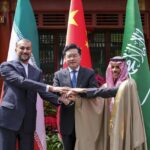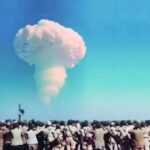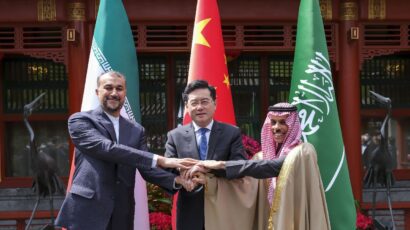Nuclear weapons: The modernization myth
By Kingston | December 8, 2009
The belief that the United States is the only declared nuclear power that isn’t modernizing its nuclear arsenal is fast becoming an article of faith in nuclear weapon policy circles. As Arizona Republican Sen. Jon Kyl put it last summer, “Every nuclear weapons power–with the exception of the United States–is currently modernizing its nuclear weapons and weapons delivery systems.”
From this belief arises a dangerous argument: U.S. allies and adversaries are adding new nuclear weapons and capabilities, while Washington is allowing its nuclear forces to atrophy. Opponents of President Barack Obama’s nonproliferation and disarmament agendas are using this idea as a way of undermining his plans, alleging that by not modernizing, the United States is in danger of being surpassed by Russia and China. Yet these arguments are specious and misleading.
By narrowly defining “modernization” as the production and deployment of new warheads and delivery vehicles, an inappropriate standard is set by which to judge the health of a nuclear arsenal. What matters far more than the age of warheads and other equipment is whether a country has a reliable, credible deterrent. Viewed in this light, the United States cannot be said to be falling behind: Washington takes continual steps to ensure that its arsenal remains dominant, and indeed, its nuclear arsenal remains second to none.
That Washington doesn’t follow the same approach to maintaining its forces as Russia, China, Britain, or France isn’t a sign of weakness or neglect. After all, constantly churning out new systems isn’t necessarily the mark of a more reliable, credible, or threatening force. In so far as the United States has pursued a different approach from other countries, it is because this approach has proven to be remarkably effective. In fact, a comparison of the status of the U.S., Russian, Chinese, British, and French arsenals and modernization programs demonstrates the fallaciousness of the implication that Washington is falling behind; it also undercuts the idea that the United States is the least active nuclear weapon state in terms of updating its forces.
The United States. Washington deploys approximately 2,200 strategic warheads and 500 tactical warheads and maintains about 2,500 warheads in reserve. It preserves and refurbishes its existing nuclear arsenal through a variety of stockpile stewardship and life-extension programs that have lengthened the life span and increased the lethality of its existing forces.
Both U.S. submarine-launched and land-based long-range missiles are now undergoing life-extension programs. For example, the air force will soon complete a 10-year, $6 billion sustainment effort to increase missile reliability and extend the life of the Minuteman III missile to 2030. This program is somewhat akin to refurbishing a computer; the actual missile doesn’t need to be replaced because the updated components are brand new. From 1997 to 2001, the United States also produced and deployed a new variant of the B61 gravity bomb. Known as the B61-11, it functions as an earth-penetrating weapon (i.e., “bunker-buster”).
Since implementing a moratorium on nuclear testing in 1992, Washington has chosen to maintain and refurbish its nuclear warheads through science-based efforts to retain confidence in the safety and reliability of its arsenal absent nuclear testing. A recent non-nuclear refurbishment of the W76 warhead fitted it with a new arming, firing, and fusing mechanism that gives it a hard-target kill capability.
Such upgrades have increased the deadliness of the U.S. nuclear arsenal. At the end of the Cold War, a U.S. submarine-launched warhead had about a 12 percent chance of destroying a hardened Russian missile silo; the two types of submarine-launched warheads deployed today (the W76 and W88) can destroy a hardened missile silo 90 percent and 98 percent of the time respectively, according to one estimate.
Washington also has plans to develop a new class of nuclear-powered ballistic missile submarines (SSBM) and a new long-range nuclear bomber. The new submarine, dubbed the SSBN-X, would replace the current fleet of 14 Ohio-class submarines. In its 2010 budget request, the Obama administration requested $700 million for research and development for the SSBN-X. Construction is scheduled to begin in 2019. Procurement of the air force’s next-generation bomber was scheduled to begin a year earlier, but in April, Defense Secretary Robert Gates announced that the administration would delay the program “until we have a better understanding of the need, the requirement, and the technology.” However, there is a strong chance that the bomber will reemerge in the fiscal year 2011 budget.
These plans to develop a new submarine and bomber belie the notion that the United States is the only nation that isn’t producing new nuclear weaponry. A new, limited capability to remanufacture plutonium pits, the core of thermonuclear weapons, also has been initiated. Along these lines, in June 2007, Los Alamos National Laboratory delivered a newly manufactured W88 pit–constructed with new materials via a new process–that was certified to be interchangeable with pits first produced in 1988.
Russia. Russian nuclear forces continue to shrink because Moscow is retiring older systems faster than it is adding new weapons. Today, Russia deploys approximately 4,800 strategic and tactical warheads. Although Moscow plans to cut in half its existing arsenal of 600-700 delivery vehicles over the next decade, it is extensively modernizing its older delivery systems. The newest systems under development are the Topol-M long-range missile and the Borey-class submarine with its associated Bulava submarine-launched ballistic missiles (SLBMs). Russian officials had hoped that the Bulava would enter production before 2010, but frequent test failures, in conjunction with the recent resignation of the director of the bureau that’s developing the missile, have thrown the future of the program into doubt. Moscow is preparing to begin to deploy its new RS-24 missile–reportedly a multiple-warhead version of the Topol-M–this month to coincide with the expiration of START. Russian officials argue that the RS-24 is central to maintaining the credibility of its deterrent, in part because it will be able to penetrate U.S. missile defenses.
Moscow maintains a robust nuclear warhead production capability, regularly remanufacturing each warhead every 10 to 15 years–a necessity because Russian warheads aren’t nearly as well maintained as U.S. warheads. As such, they begin to suffer from age-related defects much sooner. As Victor Reis, assistant secretary of energy for defense programs, remarked in a 1998 hearing before the House Appropriations Subcommittee on Energy and Water Development, “[The Russians] have a somewhat different system where they do tend to go back and remanufacture the whole system. Their system, as best we understand it, is perhaps not quite as finely tuned as ours. . . . They are very concerned about that issue.”
China. Beijing’s stockpile consists of approximately 200-250 strategic warheads. It is expanding its nuclear force, but at nowhere near the pace of U.S. intelligence estimates, which repeatedly have overestimated the speed and content of China’s modernization programs. New Chinese delivery systems include the solid-fueled DF-31 long-range missile; the DF-31A intercontinental ballistic missile, which Beijing began deploying in 2008; and the JL-2, an SLBM variant of the DF-31. Development and deployment of these systems has proceeded at an exceedingly slow pace: China’s decision to replace older, liquid-fueled systems with these solid-fueled systems dates back to the 1970s or 1980s, yet it is just now beginning to deploy them. (See “Engaging China and Russia on Nuclear Disarmament.”) Beijing is also thought to be interested in developing multiple independently targetable reentry vehicles for some of its delivery systems, perhaps due in part to concerns about U.S. missile defense.
China has one Xia-class SSBN, and it is believed to have deployed one new Jin-class submarine in early 2008. Two or three more Jin-class submarines are thought to be under construction. However, it isn’t clear how China plans to operate a sea-based deterrent, and no Chinese ballistic missile submarine has ever sailed on a deterrent patrol.
Like Russia, China maintains a robust nuclear weapons production infrastructure. As such, Beijing probably is manufacturing the warheads (based on previously tested designs) for its new delivery systems.
France. The French nuclear stockpile holds approximately 350 strategic warheads, consisting of two warhead designs deployed on four ballistic missile submarines and four aircraft squadrons. Since 1996 Paris has been modernizing its naval force, replacing its older Le Redoutable-class submarines with the newer Le Triomphant-class submarines, which carry the M45 SLBM. The newest, Le Terrible, will become operational in 2010 and will be the first to carry the more advanced, longer-range M51 SLBMs, which will replace the M45s. French SLBMs now carry the TN75 warhead, but beginning in 2015, they will carry the more robust Tête Nucléaire Océanique (TNO) warhead. Likewise, the TN81 warhead currently deployed on French nuclear bombers will be replaced with the Tête Nucléaire Aero-portée (TNA) warhead, which Paris began producing in 2007. France tested the TN75, TNO, and TNA designs during a final series of nuclear tests in September 1996.
Paris also is upgrading its nuclear bombers. Sometime next year the new Rafale fighter is scheduled to begin replacing three squadrons of land-based Mirage aircraft and a single squadron of carrier-based Super Etendard. The Rafale will carry the advanced Air-Sol Moyenne Portée-Amélioré (ASMP-A) air-launched missile, which will replace the ASMP missiles currently carried by the Mirage and Super Etendard fighters.
Britain. London is taking the least aggressive approach to modernization. Currently, Britain deploys fewer than 160 strategic warheads of the same type on approximately four Vanguard-class SSBNs that carry Trident II SLBMs. In late 2006, the British government announced that it planned to build a follow-on to the Vanguard-class submarines. But in July, it decided to delay the design contract until 2010–a decision that was made public as Prime Minister Gordon Brown unveiled “The Road to 2010,” a yearlong, British-led effort to address key nuclear challenges in the lead-up to the 2010 Nuclear Non-Proliferation Treaty Review Conference, including “progress in building the international partnerships we need to deliver a world free from nuclear weapons.”
The sole warhead design in the British stockpile is based on the U.S. W76. British warheads undergo maintenance and refurbishment at the Atomic Weapons Establishment at Aldermaston, but it’s unlikely that the establishment could produce all of the W76 components by itself because of Britain’s heavy reliance on U.S. warhead designs and refurbishment technologies. In 2007, it was reported that London was preparing a design for a new “high surety warhead” modeled after the U.S. reliable replacement warhead (RRW). But since the Obama administration didn’t request funds for the RRW Program in its fiscal year 2010 budget, it isn’t clear how Britain can proceed with its high surety warhead.
Evaluating the arsenals. Obviously, the slow pace of Russian and Chinese strategic modernization programs neither increases the threat to Washington nor threatens U.S. nuclear dominance. Furthermore, French and British efforts to modernize their forces never posed any threat to the United States in the first place.
Nonetheless, some still argue that if Washington doesn’t pursue a more robust modernization program, the United States will send the signal that it doesn’t take nuclear deterrence seriously. These concerns are mistaken. First, the United States clearly isn’t allowing its nuclear deterrent to deteriorate: Due to remarkable advances in stockpile stewardship capabilities and life-extension efforts, the U.S. nuclear stockpile and its supporting infrastructure remain the most sophisticated and modern in the world. U.S. delivery systems are more deadly and more accurate than they were during the Cold War. Both the defense secretary and the energy secretary annually certify the reliability of U.S. warheads, even though Washington conducted its last nuclear test 17 years ago. Numerous studies have concluded that the explosive cores in U.S. warheads will remain reliable for many, many years. Plus according to a September report from the JASON scientific advisory group, “Lifetimes of today’s nuclear warheads could be extended for decades, with no anticipated loss in confidence by using approaches similar to those employed in [life-extension programs] to date.”
Second, Washington continues to spend huge sums of money on its nuclear forces. A recent study calculated that the United States devoted at least $29.1 billion to its nuclear forces and operational support in fiscal year 2008, including more than $6 billion for the Stockpile Stewardship Program.
So those who continue to argue that Washington doesn’t show enough interest in modernizing its nuclear weapons should be forced to answer a simple question: If given the choice, would they trade the U.S. nuclear arsenal for the Russian or Chinese nuclear arsenals? Clearly, the answer is no. The appropriate mission for U.S. nuclear weapons is deterrence. And the U.S. arsenal of more than 5,000 nuclear weapons has the capacity to deter any threat regardless of how many resources Russia, China, and/or any other country devote to modernizing their arsenals.
Together, we make the world safer.
The Bulletin elevates expert voices above the noise. But as an independent nonprofit organization, our operations depend on the support of readers like you. Help us continue to deliver quality journalism that holds leaders accountable. Your support of our work at any level is important. In return, we promise our coverage will be understandable, influential, vigilant, solution-oriented, and fair-minded. Together we can make a difference.
Topics: Nuclear Weapons, Opinion















